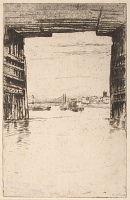Etchings Institutions search term: british museum
Under Old Battersea Bridge | ||
| Number: | 168 | |
| Date: | 1876/1878 | |
| Medium: | etching, drypoint and open bite | |
| Size: | 216 x 139 mm | |
| Signed: | no | |
| Inscribed: | no | |
| Set/Publication: | 'Cancelled Plates', 1879 | |
| No. of States: | 3 | |
| Known impressions: | 24 | |
| Catalogues: | K.176; M.173 | |
| Impressions taken from this plate (24) | ||
TECHNIQUE
The bridge was etched deeply and the distant river scene added in drypoint. Open bite (painting acid on the plate) was used to produce the richly textured dark mass of the bridge and its piers in the second state. In the sole known impression of the second state a small rowing boat is sketched in the foreground or rather fore-water ( ). This was never added on the copper plate.
). This was never added on the copper plate.
 ). This was never added on the copper plate.
). This was never added on the copper plate.
In the final state careful shading in drypoint was used to create a softer, more atmospheric effect in the distance, but this faded quickly.
PRINTING
This etching is fairly rare. There may have been four or five impressions of the first state, since one is numbered '5.' on the recto ( ); it is possible that there are further untraced impressions. All impressions were printed in black ink. The first proof was printed on cream laid paper with the De Erven De Blauw watermark, and is a slightly slipped impression (
); it is possible that there are further untraced impressions. All impressions were printed in black ink. The first proof was printed on cream laid paper with the De Erven De Blauw watermark, and is a slightly slipped impression ( ). Another first state, numbered '2' possibly by Whistler, is on ivory laid paper with the watermark of a beehive and 'DEDB' (
). Another first state, numbered '2' possibly by Whistler, is on ivory laid paper with the watermark of a beehive and 'DEDB' ( ); the impression numbered '5' is on darkened ivory paper with 'Pro Patria' watermark (
); the impression numbered '5' is on darkened ivory paper with 'Pro Patria' watermark ( ).
).
 ); it is possible that there are further untraced impressions. All impressions were printed in black ink. The first proof was printed on cream laid paper with the De Erven De Blauw watermark, and is a slightly slipped impression (
); it is possible that there are further untraced impressions. All impressions were printed in black ink. The first proof was printed on cream laid paper with the De Erven De Blauw watermark, and is a slightly slipped impression ( ). Another first state, numbered '2' possibly by Whistler, is on ivory laid paper with the watermark of a beehive and 'DEDB' (
). Another first state, numbered '2' possibly by Whistler, is on ivory laid paper with the watermark of a beehive and 'DEDB' ( ); the impression numbered '5' is on darkened ivory paper with 'Pro Patria' watermark (
); the impression numbered '5' is on darkened ivory paper with 'Pro Patria' watermark ( ).
). Impressions of the third state show clearly the extensive use of tonal medium to accentuate the structure of the massive piers and the arch above them. Two of these impressions are on ivory laid paper; one is a slightly slipped impression ( ) and the other has the water- or counter-mark 'IH' (
) and the other has the water- or counter-mark 'IH' ( ). It is printed on a sheet that has old notes on the verso in Latin, referring to the governance of Judaea, with a reference to the Roman historian Suetonius (ca 69/75 – after 130).
). It is printed on a sheet that has old notes on the verso in Latin, referring to the governance of Judaea, with a reference to the Roman historian Suetonius (ca 69/75 – after 130).
 ) and the other has the water- or counter-mark 'IH' (
) and the other has the water- or counter-mark 'IH' ( ). It is printed on a sheet that has old notes on the verso in Latin, referring to the governance of Judaea, with a reference to the Roman historian Suetonius (ca 69/75 – after 130).
). It is printed on a sheet that has old notes on the verso in Latin, referring to the governance of Judaea, with a reference to the Roman historian Suetonius (ca 69/75 – after 130).
Under Old Battersea Bridge was published in an album of Cancelled Plates ('Cancelled Set') by The Fine Art Society, London, 1879. There may have been an edition of about 20 or 24. Impressions from the cancelled plate print remarkably strongly, despite the cancellation marks. They were professionally printed in black ink on ivory laid paper, some watermarked, for instance, with the Strasbourg Lily ( ) and Van Gelder (
) and Van Gelder ( ).
).
 ) and Van Gelder (
) and Van Gelder ( ).
).
